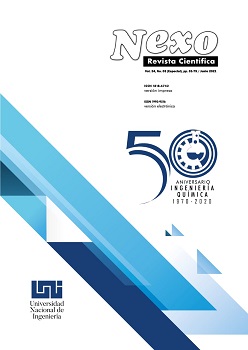Drying kinetics and thermodynamic analysis of tomato in a tunnel dryer
DOI:
https://doi.org/10.5377/nexo.v34i03.11859Keywords:
Tomato, Drying kinetics, Energy, Exergy, EfficiencyAbstract
In this study, drying kinetics and thermodynamic analysis of tomato were conducted in a tunnel dryer. Drying experiments were performed at three temperatures (100, 115, and 130 °C) and an air velocity of 1.45 m/s. From the drying curves, only a falling rate period was observed. Under these conditions, a characteristic drying curve was determined. It is observed that at the 40 minutes of the drying process, the outlet gas enthalpy achieved a maximum value that is very close to the inlet value and remained constant until the end of the process. Entropy exhibited similar behaviour to enthalpy. The maximum value of the exergy efficiency curve corresponds to the maximum value observed within the drying rate curves. This maximum value represents the stage when the available energy is efficiently used in moisture removal. As the drying rate decreases the available energy is started to be less employed.
Downloads
1664
Downloads
Published
How to Cite
Issue
Section
License
Copyright (c) 2021 Universidad Nacional de Ingeniería

This work is licensed under a Creative Commons Attribution 4.0 International License.
The authors who publish in Nexo Scientific Journal agree to the following terms:
- Authors retain the copyright and grant the journal the right of the first publication under the license Creative Commons Attribution License, which allows others to share the work with a recognition of the authorship of the work and the initial publication in Nexo Scientific Journal.
- Authors may separately establish additional agreements for the non-exclusive distribution of the version of the work published in the journal (for example, in an institutional repository or a book), with the recognition of the initial publication in Nexo Scientific Journal.
- Authors are allowed and encouraged to disseminate their works electronically (for example, in institutional repositories or in their own website) before and during the submission process, as it can lead to productive exchanges, as well as earlier and greater citation of published works.










